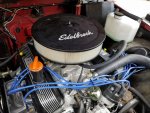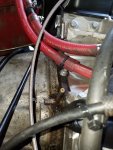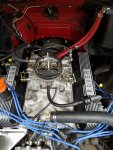Defender425
Member
Just finished rebuilding my 3.5 V8 which has Edelbrock manifold and carb. Originally when I fitted that manifold and carb I had the rocker vent lines tee'd and going to the filtered side of the air cleaner. Ended up filling the aircleaner with oil so figured I needed to do it better after rebuilding engine. (Note- before rebuilding the engine was a mess with 3-4 very leaky cylinders and leaking valve seals so that contributed to some of the issues with oil in the air cleaner.)
I set it up using a PCV valve that "looked about right" attached to LH rocker cover with PCV valve going to port on front of carb and the RH rocker cover line going to air cleaner. After about 200 miles I am still getting oil in air cleaner.
So after reading as much as I could I learned that originally there is no PCV but there is a metered port on the rear of the valley in the block. So I removed the PCV valve and capped the RH rocker cover and connected the LH one directly to the port on the manifold. Works great, actually too great at idle!! Also causes another issue is that I can't get the idle slow enough because of the amount of additional air at idle entering the manifold. Pinching the line helps a lot getting a good idle speed. Also means that any leak in the covers or lines becomes a vacuum leak in the intake system.
So with that long winded explanation of my dilemma I think the best would be to set it up using a PCV valve to shut off or at least severely restrict the flow at idle so I can get a good idle and use the metered port as designed to allow air to enter block.
So what is the right PCV valve to use???? Need one sized correctly and also that is a configuration I can adapt to the engine. Anyone have a good part number or make and model to use?
Welcome any other suggested setup ideas that work. I feel like I am overthinking this!!
Thanks, Jeremy
I set it up using a PCV valve that "looked about right" attached to LH rocker cover with PCV valve going to port on front of carb and the RH rocker cover line going to air cleaner. After about 200 miles I am still getting oil in air cleaner.
So after reading as much as I could I learned that originally there is no PCV but there is a metered port on the rear of the valley in the block. So I removed the PCV valve and capped the RH rocker cover and connected the LH one directly to the port on the manifold. Works great, actually too great at idle!! Also causes another issue is that I can't get the idle slow enough because of the amount of additional air at idle entering the manifold. Pinching the line helps a lot getting a good idle speed. Also means that any leak in the covers or lines becomes a vacuum leak in the intake system.
So with that long winded explanation of my dilemma I think the best would be to set it up using a PCV valve to shut off or at least severely restrict the flow at idle so I can get a good idle and use the metered port as designed to allow air to enter block.
So what is the right PCV valve to use???? Need one sized correctly and also that is a configuration I can adapt to the engine. Anyone have a good part number or make and model to use?
Welcome any other suggested setup ideas that work. I feel like I am overthinking this!!
Thanks, Jeremy




